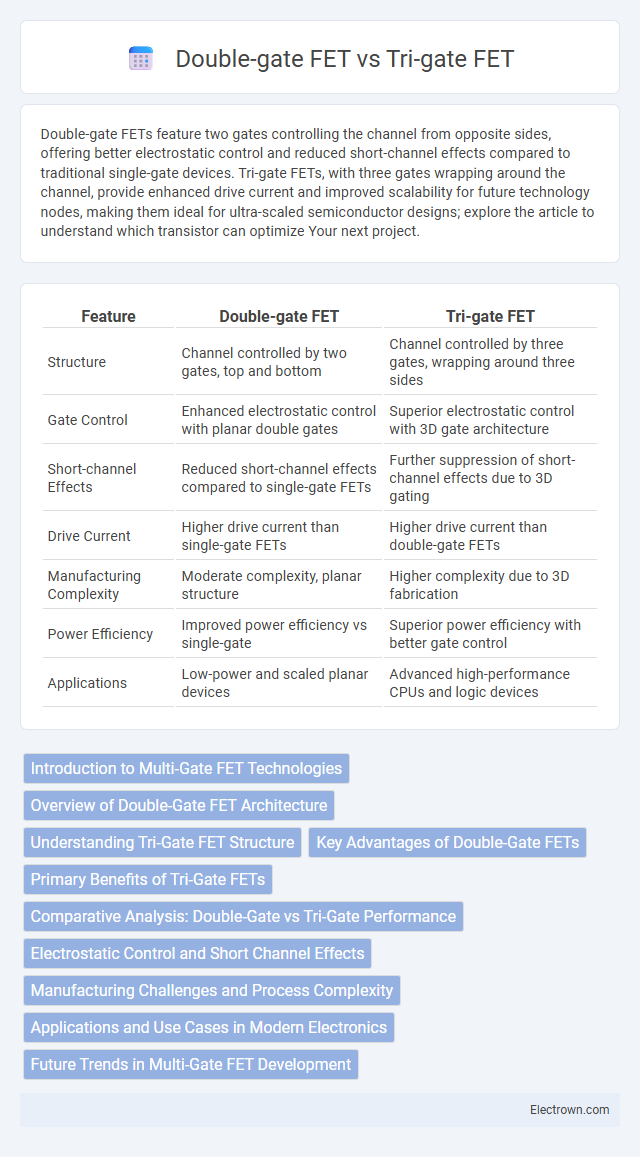Double-gate FETs feature two gates controlling the channel from opposite sides, offering better electrostatic control and reduced short-channel effects compared to traditional single-gate devices. Tri-gate FETs, with three gates wrapping around the channel, provide enhanced drive current and improved scalability for future technology nodes, making them ideal for ultra-scaled semiconductor designs; explore the article to understand which transistor can optimize Your next project.
Table of Comparison
| Feature | Double-gate FET | Tri-gate FET |
|---|---|---|
| Structure | Channel controlled by two gates, top and bottom | Channel controlled by three gates, wrapping around three sides |
| Gate Control | Enhanced electrostatic control with planar double gates | Superior electrostatic control with 3D gate architecture |
| Short-channel Effects | Reduced short-channel effects compared to single-gate FETs | Further suppression of short-channel effects due to 3D gating |
| Drive Current | Higher drive current than single-gate FETs | Higher drive current than double-gate FETs |
| Manufacturing Complexity | Moderate complexity, planar structure | Higher complexity due to 3D fabrication |
| Power Efficiency | Improved power efficiency vs single-gate | Superior power efficiency with better gate control |
| Applications | Low-power and scaled planar devices | Advanced high-performance CPUs and logic devices |
Introduction to Multi-Gate FET Technologies
Multi-gate FET technologies such as Double-gate FETs and Tri-gate FETs enhance transistor performance by improving channel control and reducing short-channel effects. Double-gate FETs utilize two gates on opposite sides of the channel, while Tri-gate FETs wrap the gate around three sides, offering superior electrostatic control and scalability at nanoscale dimensions. Your choice between these devices impacts power efficiency, leakage current, and overall transistor density in advanced integrated circuits.
Overview of Double-Gate FET Architecture
Double-Gate FET architecture features two gates controlling a thin silicon channel from opposite sides, enhancing electrostatic control and reducing short-channel effects compared to single-gate FETs. This configuration improves drive current and suppresses leakage currents, making it ideal for low-power and high-performance integrated circuits. Your semiconductor designs benefit from increased scalability and better device reliability using Double-Gate FETs in advanced CMOS technologies.
Understanding Tri-Gate FET Structure
The Tri-Gate FET structure features a three-dimensional design with the channel wrapped on three sides by the gate, significantly improving electrostatic control compared to the double-gate FET, which only has the gate on two opposite sides of the channel. This enhanced gate control in Tri-Gate FETs reduces short-channel effects, leading to better subthreshold slope, higher drive current, and lower leakage currents. Advanced semiconductor manufacturers like Intel utilize Tri-Gate FETs in their 22nm and smaller nodes to achieve superior performance and energy efficiency in modern integrated circuits.
Key Advantages of Double-Gate FETs
Double-gate FETs offer superior electrostatic control over the channel compared to tri-gate FETs, resulting in reduced short-channel effects and lower leakage currents. Their symmetric gate structure enables enhanced drive current and improved subthreshold slope, leading to better device performance in deep nanoscale regimes. Double-gate FETs also exhibit simpler fabrication processes than tri-gate architectures, contributing to potentially lower manufacturing costs and higher yield.
Primary Benefits of Tri-Gate FETs
Tri-gate FETs enhance electrostatic control by wrapping the gate electrode on three sides of the channel, significantly reducing short-channel effects compared to double-gate FETs with gates on only two sides. This three-dimensional gate architecture improves drive current and energy efficiency, enabling higher performance in modern semiconductor devices. Tri-gate FETs also deliver better scalability and reduced leakage current, making them ideal for advanced process nodes in high-performance and low-power applications.
Comparative Analysis: Double-Gate vs Tri-Gate Performance
Double-gate FETs provide superior electrostatic control due to their two gates flanking the channel, reducing short-channel effects and improving subthreshold slope compared to single-gate devices. Tri-gate FETs, with three surrounding gates, enhance carrier mobility and current drive by offering better gate control and reduced leakage at advanced technology nodes. Your choice between these architectures depends on balancing ultralow power requirements with higher drive currents for optimized device performance in nanoscale CMOS technology.
Electrostatic Control and Short Channel Effects
Double-gate FETs provide superior electrostatic control over the channel by using two gates on opposite sides, significantly reducing short channel effects compared to single-gate devices. Tri-gate FETs enhance electrostatic control further by surrounding the channel on three sides, improving gate control and suppressing short channel effects more effectively in advanced technology nodes. This geometry leads to better threshold voltage stability and reduced leakage currents, making tri-gate devices preferable for scaling beyond 10 nm.
Manufacturing Challenges and Process Complexity
Double-gate FETs face manufacturing challenges due to precise alignment and etching requirements on both sides of the channel, making process control critical and increasing complexity. Tri-gate FETs introduce further fabrication intricacies by requiring 3D structures with gate material wrapped around three sides of the channel, which demands advanced lithography and deposition techniques. Your choice between these technologies should consider the trade-offs in process complexity and yield impact within semiconductor manufacturing.
Applications and Use Cases in Modern Electronics
Double-gate FETs excel in low-power integrated circuits and high-speed digital applications due to their superior electrostatic control and reduced short-channel effects. Tri-gate FETs are widely adopted in advanced microprocessors and high-performance computing devices, offering enhanced drive current and better scalability for 3D transistor architectures. Both device types are critical in modern electronics for improving energy efficiency and device density in DRAM, SRAM, and logic circuits.
Future Trends in Multi-Gate FET Development
Multi-gate FET development is trending towards enhanced electrostatic control and scalability, with Tri-gate FETs gaining prominence due to their superior channel control and reduced short-channel effects compared to Double-gate FETs. Future innovations will likely emphasize materials engineering and 3D architecture integration to boost drive current and energy efficiency for next-generation high-performance computing. Your design choices will benefit from understanding these shifts toward Tri-gate structures as they offer greater flexibility for device miniaturization and power management.
Double-gate FET vs Tri-gate FET Infographic

 electrown.com
electrown.com